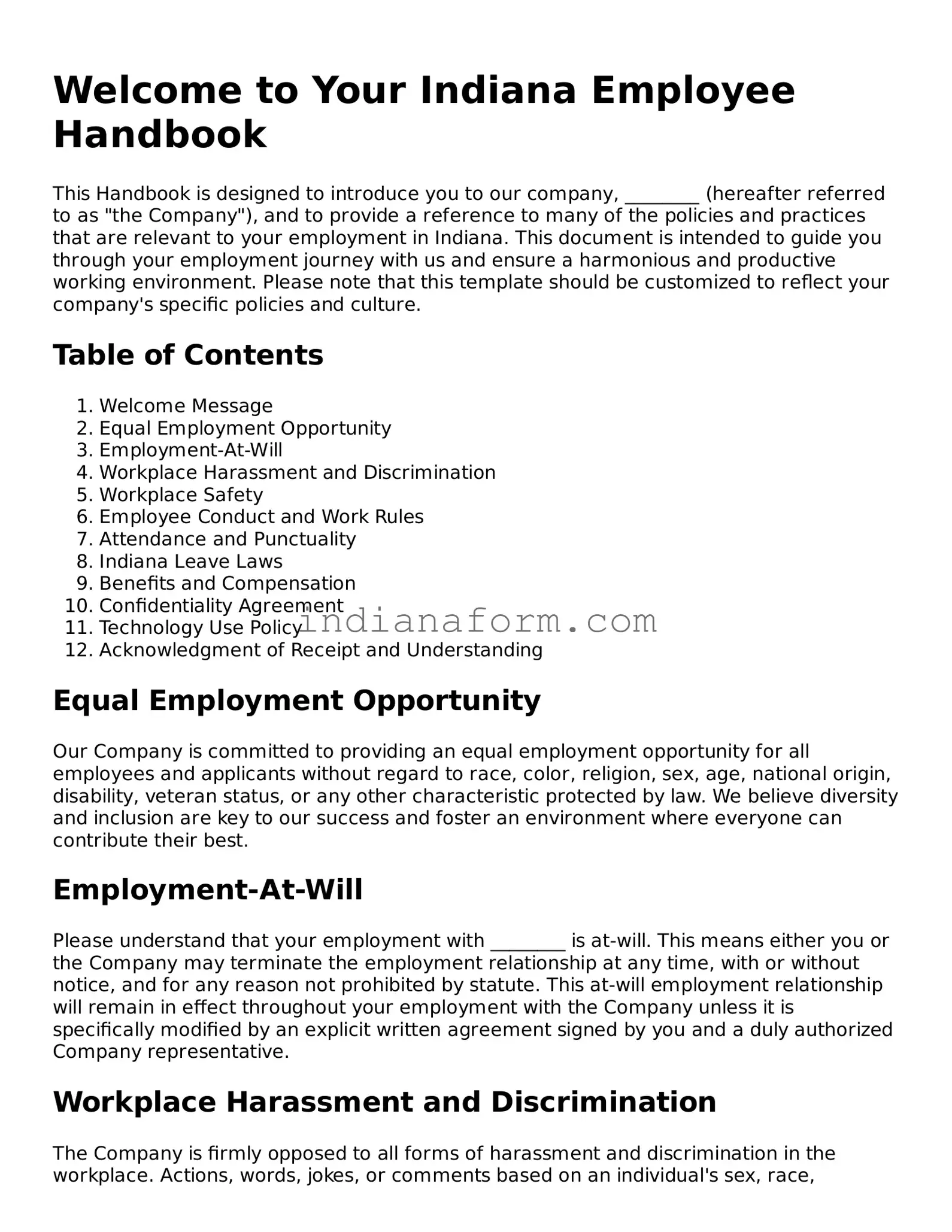Welcome to Your Indiana Employee Handbook
This Handbook is designed to introduce you to our company, ________ (hereafter referred to as "the Company"), and to provide a reference to many of the policies and practices that are relevant to your employment in Indiana. This document is intended to guide you through your employment journey with us and ensure a harmonious and productive working environment. Please note that this template should be customized to reflect your company's specific policies and culture.
Table of Contents
- Welcome Message
- Equal Employment Opportunity
- Employment-At-Will
- Workplace Harassment and Discrimination
- Workplace Safety
- Employee Conduct and Work Rules
- Attendance and Punctuality
- Indiana Leave Laws
- Benefits and Compensation
- Confidentiality Agreement
- Technology Use Policy
- Acknowledgment of Receipt and Understanding
Equal Employment Opportunity
Our Company is committed to providing an equal employment opportunity for all employees and applicants without regard to race, color, religion, sex, age, national origin, disability, veteran status, or any other characteristic protected by law. We believe diversity and inclusion are key to our success and foster an environment where everyone can contribute their best.
Employment-At-Will
Please understand that your employment with ________ is at-will. This means either you or the Company may terminate the employment relationship at any time, with or without notice, and for any reason not prohibited by statute. This at-will employment relationship will remain in effect throughout your employment with the Company unless it is specifically modified by an explicit written agreement signed by you and a duly authorized Company representative.
Workplace Harassment and Discrimination
The Company is firmly opposed to all forms of harassment and discrimination in the workplace. Actions, words, jokes, or comments based on an individual's sex, race, ethnicity, age, religion, or any other legally protected characteristic will not be tolerated. Indiana Civil Rights Laws specifically protect employees and applicants from discrimination in various facets of employment. Any employee who feels harassed or discriminated against should report the matter immediately to their supervisor or human resources representative.
Workplace Safety
Ensuring a safe workplace is a core principle of our Company. We adhere to the standards and regulations issued under the Indiana Occupational Safety and Health Administration (IOSHA). It is the responsibility of each employee to comply with all safety and health regulations, including the use of protective equipment and reporting any accidents, injuries, and unsafe equipment, practices, or conditions.
Employee Conduct and Work Rules
To maintain an efficient, productive, and positive work environment, the Company has established certain rules of conduct that all employees are expected to follow. These rules pertain to professional behavior, respect for coworker and company property, attendance, confidentiality, and conflict of interest, among others. Violation of these rules may result in disciplinary action, up to and including termination of employment.
Attending and Punctuality
Regular attendance and punctuality are important to keep your team and our Company operating effectively. While occasional delays may be unavoidable, consistent punctuality is expected. Please promptly inform your supervisor if you expect to be late or absent.
Indiana Leave Laws
In compliance with Indiana specific leave laws, our Company provides various leave benefits to eligible employees, including Family and Medical Leave, Military Leave, Jury Duty Leave, and others as provided by state law. Detailed information about the types of leave, eligibility criteria, and procedures for requesting leave can be found in our leave policies.
Benefits and Compensation
The Company offers a competitive benefits package, including health insurance, retirement plans, paid time off, and other benefits aimed at supporting the wellbeing of our employees and their families. Details about the compensation and benefits plan specific to your position will be provided upon hire and during annual enrollment periods.
Confidentiality Agreement
As an employee, you may be privy to confidential information pertaining to the Company's operations, clients, or future business strategies. You are required to sign a confidentiality agreement as a condition of your employment, agreeing not to disclose this sensitive information during or after your employment with the Company.
Technology Use Policy
The Company's technological resources, including computers, internet access, and email, are provided for job-related purposes. While limited personal use is permissible, it should not interfere with your duties. Misuse of the Company's technology can lead to disciplinary action.
Acknowledgment of Receipt and Understanding
Each employee is required to sign an acknowledgment that they have received, read, and understood the contents of this Employee Handbook and agree to abide by the policies and procedures it contains. This acknowledgment does not alter the at-will employment relationship between you and the Company.
